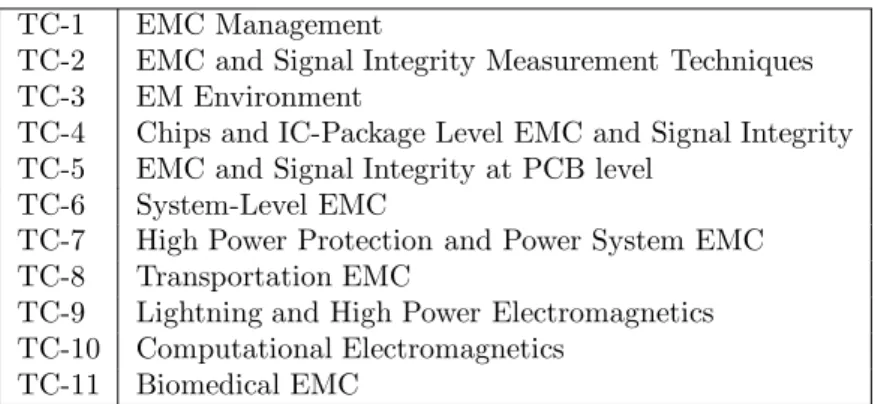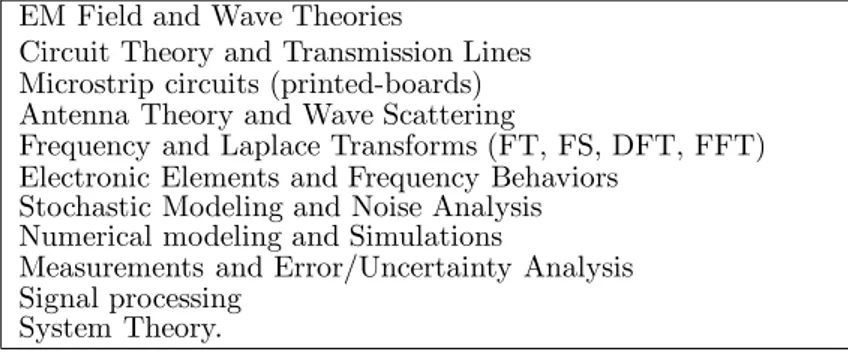Electromagnetic compatibility engineering education:
problems, challenges and perspectives
Levent SEVG˙I
Electronics and Communication Engineering Department, Do˘gu¸s University, Zeamet sok. No.21, Acıbadem, 34722, ˙Istanbul-TURKEY
e-mail: lsevgi@dogus.edu.tr
Abstract
Education and training problems and challenges in EMC Engineering are discussed. The necessity of physics-based modeling (theory) and hands-on training (practice) are emphasized. An introductory level EMC lecture and a short course outline are given for modern EMC education.
Key Words: Electromagnetic Compatibility, EMC, EMC education, Electromagnetic Engineering.
1.
Introduction
Electromagnetic waves play an increasingly important role in electronics and communication systems. Growth continues in wireless systems, home networking areas, wireless local area networks (WLANs) and wireless personal area networks (WPANs). Next generation technologies are taking root in a number of countries. All these come about via high technology electronic system design. This in turn requires Electromagnetic Compatibility (EMC) engineers with strong theory and practice.
EMC engineering is a multidisciplinary activity and involves physics, electronics, mechanics, chemistry and medicine. It has design, tests, production, quality, marketing, and legal implications. A conventional electromagnetic engineer is concerned with a range of product specific issues, whereas EMC engineers are concerned with all possible external electromagnetic influences on the environment. Issues related to EMC-BEM engineering has been addressed on various platforms by experts for the last couple of years [1-14].
This paper discusses EMC Engineering education. First, problems and challenges related to EMC engineering are reviewed. Then, a summary for an undergraduate (introductory) level EMC engineering lecture and/or a few day condensed EMC course outline is given. Finally, the conclusions are outlined.
2.
Nature of problems in EMC engineering
Understanding EMC is important to manufacture less interfering, less susceptible and more compatible products [1–8]. The key issue here is the physics of the problem therefore, physics-based modeling and observable-based parameterization are essential.
EMC activities include tests and measurements to determine the level of emissions from a product, and the product’s immunity to outside electrical environment, either by conduction or electromagnetic radiation. The frequency range has no specific limits but is generally concerned with that part of the electromagnetic spectrum used for supply, industrial processes, communications, navigation and radar. Immunity to disturbances and variations in the electrical mains supply, such as: spikes, surges, dips and harmonics are normally considered as EMC tests. The procedure for all EMC tests and measurements are specified by standards; basic, generic, product family or product specific.
Emission tests are quite straightforward. Although requirements like “the worst emission direction is determined first”, or “main and auxiliary devices are connected in a way to yield highest emission”, etc., make it difficult, emission tests and measurements are still easier than immunity tests. While measured emission values are recorded and compared with the threshold values specified in the related standards, quite different performance criteria are used for immunity tests, where device under test is monitored in a high level electromagnetic energy environment.
3.
Problems and challenges in EMC engineering
The best way to understand and discuss EMC problems and challenges is to follow technical chapters in prestigious EMC related conferences and symposiums. Table 1 lists the most recent EMC Zurich 2009 Conference topics (www.emc-zurich.ch). This list can be compared with the previous topics listed in the same EMC conference. As seen from the table, chip and IC level EMC problems, system level integration problems, transportation EMC, high power EMC problems are among a few current challenges.
Table 1. Current problems and challenges in EMC engineering.
TC-1 EMC Management
TC-2 EMC and Signal Integrity Measurement Techniques TC-3 EM Environment
TC-4 Chips and IC-Package Level EMC and Signal Integrity TC-5 EMC and Signal Integrity at PCB level
TC-6 System-Level EMC
TC-7 High Power Protection and Power System EMC TC-8 Transportation EMC
TC-9 Lightning and High Power Electromagnetics TC-10 Computational Electromagnetics
TC-11 Biomedical EMC
An EMC engineer should be well-equipped theoretically and practically in terms of the topics listed in Table 2. First of all field and circuit theory background is essential. These two establish the fundamentals of EMC engineering. Transmission lines, antennas, microstrip circuits are also important. Fourier analysis is another important topic. Mathematical definitions of Fourier series and transforms, numerical implementations
in terms of discrete or fast Fourier transforms (DFT, FFT) are crucial. Deterministic and stochastic modeling approaches, numerical simulation techniques are all used in EMC engineering. Finally, hands-on tests and training occupy important role in EMC engineering.
Topics to be covered also include fundamental concepts such as accuracy (the ability of an instrument to measure true value within stated error specifications), precision (the ability to repeat measurements), resolution (the smallest change in value that an instrument can detect), error, uncertainty, physical problems and modeling, discrete environment, analytical models, numerical models, deterministic and stochastic modeling, simulation, validation, and verification. Basic terms and concepts which are crucial in EMC engineering are listed in Table 3.
Table 2. Topics should be covered by EMC engineering curricula.
EM Field and Wave Theories
Circuit Theory and Transmission Lines Microstrip circuits (printed-boards) Antenna Theory and Wave Scattering
Frequency and Laplace Transforms (FT, FS, DFT, FFT) Electronic Elements and Frequency Behaviors
Stochastic Modeling and Noise Analysis Numerical modeling and Simulations
Measurements and Error/Uncertainty Analysis Signal processing
System Theory.
Table 3. Basic engineering terms and concepts.
The meaning of the numbers Most/Least Significant decimals Accuracy
Resolution Precision Sensitivity
Error and uncertainty Error Propagation
Deterministic and stochastic approaches Statistical Evaluations
Confidence Level of the results
Validation, verification, and accreditation
4.
An introductory level EMC lecture and course outline
The first step towards EMC engineering education may be introducing an undergraduate departmental level elective EMC course. A typical 14-week course outline of this introductory level EMC course is listed in Table 4. This content may also be given to engineers who graduated without taking any EMC related lecture as a 3-day condensed industrial EMC course.
EMC engineers should understand the physics of the problem and fundamental theorems (which requires strong knowledge of mathematics) and the principles they are dealing with. Hands-on practice and training is a must in EMC engineering education. Although, labs and test instruments have been simulated as virtual reality environments, which may be as good as the real environment, students still need hands-on training. Basic lectures, such as “measurement techniques” should be renewed accordingly. Computer simulations are as good as hands-on training, therefore, modeling and simulation lectures should be included in EMC discipline. Novel education techniques such as problem-based learning, inquiry-based teaching should be considered. Computer simulations are as necessary as hands-on training; therefore, modeling and simulation lectures should be included in EMC programs.
Table 4. A 14-week EMC lecture or a 3-day EMC course outline.
WEEKS 1-5 / DAY – 1:
EMI, Electromagnetic interference and compatibility
Electromagnetic spectrum Interference and coupling Compatibility and susceptibility
EMC - BEM Organizations
IEC, CENELEC, IEEE
IRPA, ICNIRP, WHO, European EMC Directive
Standards and limits
Basic standards
Product family and Product specific standards
Electromagnetic concepts and definitions
Electromagnetic fields and waves Antennas and propagation
Basic electric and magnetic sources
Transmission Line Modeling
Lumped and scattered parameter modeling
Low and high frequency equivalents of basic circuit elements Filter design with RLCG, Cross-talk
WEEKS 6-10 / DAY – 2:
Non-Linearity and inter-modulation effects
Harmonics and their effects Inter-modulation effects Flicker effects
Stochastic processes and noise analysis
Signals and their behaviors Noise spectrum, SNR, SIR
Frequency analysis
Fourier transformation and series Discrete Fourier transform FFT, DFT
EMC and numerical modeling
FDTD : Finite Difference Time-Domain TLM : Transmission Line Matrix MoM : Method of Moments
SSPE : Split-Step Parabolic Equation FE : Finite - Element
Table 4. Continued.
WEEKS 11-14 / DAY – 3:
Tests and measurement environments
Open field test sites and Normalized Site Attenuation (NSA) Screened room measurements
Anechoic test rooms
EMC Tests and measurements
Electromagnetic interference measurements
Conducted and radiated interference measurements
Electromagnetic compatibility and susceptibility measure-ments
Compatibility against conducted interference Compatibility against radiated interference Electrostatic Discharge tests, EMP, EFT
EMC Tests and Evaluation
Error/Uncertainty analysis Evaluation and interpretation
EMC Design and protection techniques
Screening, Grounding, shielding, filtering PCB design and microstrips
Cables and connectors
BEM and public concern
5.
Conclusions and discussions
EMC problems mostly do not obey regular rules and laws governed by well known electromagnetic wave and circuit theories, and can be solely solved by experience, very often by trial and error. EMC deals with EM interference problems where major design tools are grounding, shielding and filtering and concerns with tests and measurements in the near fields. The interdisciplinary character of EMC engineering requires novel approaches and techniques.
EMC problems usually do not agree with our expectations. The most dangerous case may be the case when the results of the measurement or simulation agree with what we expect. Therefore, an EMC-BEM engineer should never be sure of the results until all critical checks are finished. EMC engineers become more publicized parallel to exponential growth in wireless communication. They may attend to public meetings, regional activities to answer questions related to mobile phones, base stations and safety. Therefore, lectures like “Science Technology and Society,” or “Public Understanding of Science” should be included in this education.
References
[1] L. B. Felsen (ed.), “Engineering Education in the 21st Century: Issues and Perspectives,” IEEE Antennas and Propagation Magazine, 43 (6), pp. 111-121, Dec. 2001.
[2] L. B. Felsen, L. Sevgi, “Electromagnetic Engineering in the 21st Century: Challenges and Perspectives,” (intro-ductory paper) Special issue of ELEKTR ˙IK, Turkish J. of Electrical Engineering and Computer Sciences, 10 (2), pp.131-145, Feb 2002.
[3] Allen Taflove, “Why Study Electromagnetics: The first Unit in an Undergraduate Electromagnetics Course,” 44 (2), pp.132-139, Apr. 2002.
[4] L. Sevgi, “EMC and BEM Engineering Education: Physics based Modeling, Hands-on Training and Challenges,” IEEE Antennas and Propagation Magazine, 45 (2), pp.114-119, April 2003.
[5] L. Sevgi, “EMC and BEM Engineering Education: Physics based Modeling, Hands-on Training and Challenges,” IEEE Antennas and Propagation Magazine, 46 (2), pp.140-145, April 2004.
[6] L. Sevgi, C. G¨oknar, “An Intelligent Balance between Numerical and Physical Experimentation,” IEEE Potentials Magazine, 23 (4), pp.40-44, Oct/Nov 2004.
[7] L. Sevgi, “Virtual Tools/Labs in Electrical Engineering Education,” ELEKTR ˙IK, Turkish J. of Electrical Engineer-ing and Computer Sciences, 14 (1), pp., 113-127, 2006.
[8] L. Sevgi, “From Engineering Electromagnetics towards Electromagnetic Engineering,” ELEKTR ˙IK, Turkish Journal of Electrical Engineering and Computer Sciences, 16 (1), pp.i-v, Jan 2008.
[9] L. Sevgi, “A New Electromagnetic Engineering Program and Teaching via Virtual Tools,” PIER, Progress in EM Research B, 6, pp.205-224, 2008.
[10] L. Sevgi, S. C¸ akır, G. C¸ akır, “Antenna Calibration for EMC Tests and Measurements,” IEEE Antennas and Propagation Magazine, 50 (3), pp.215-224, Jun 2008.
[11] L. Sevgi, “The Antenna as a Transducer: Simple Circuit and Electromagnetic Models,” IEEE Antennas and Propagation Magazine, 49 (6), pp.211-218, Dec 2007.
[12] L. Sevgi, “Digital Multimeters and Basic Measurements,” IEEE Antennas and Propagation Magazine, 49 (4), pp.232-237,Aug 2007.
[13] L. Sevgi, “Innumeracy: The Meaning of the Numbers We Use,” IEEE Antennas and Propagation Magazine, 49 (2), pp.195-190, Apr 2007.
[14] L. Sevgi, “Electrical and Computer Engineering Education in the 21st Century: Issues, Perspectives and Challenges: Preface,” ELEKTR ˙IK, Turkish J. of Electrical Engineering and Computer Sciences, 14 (1), pp. 1-5, 2006.



